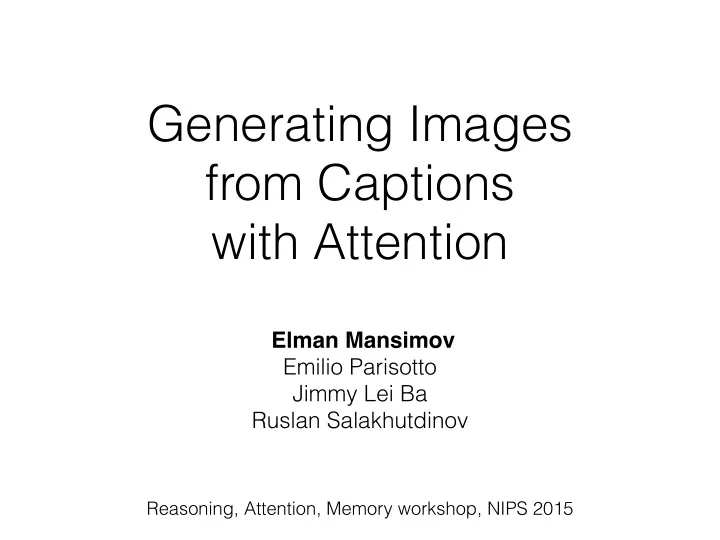

Generating Images from Captions with Attention Elman Mansimov Emilio Parisotto Jimmy Lei Ba Ruslan Salakhutdinov Reasoning, Attention, Memory workshop, NIPS 2015
Motivation • To simplify the image modelling task • Captions contain more information about the image. • Although you need to learn language model. • To better understand model generalization • Create textual descriptions of completely new scenes not seen at training time.
Novel Compositions A stop sign is flying in A pale yellow school bus is blue skies. flying in blue skies. A herd of elephants flying A large commercial airplane in blue skies. flying in blue skies.
General Idea Part of the sequence-to-sequence framework. (Sutskever et al. 2014; • Cho et al. 2014; Srivastava et al. 2015) Caption is represented as a sequence of consecutive words. • Image is represented as a sequence of patches drawn on canvas. • Also need to figure out where to put generated patches on canvas. •
Language Model (Bidirectional RNN) Forward LSTM reads • sentence from left to right Backward LSTM reads • sentence from right to left Sentence representation is • average of hidden states Cho et. al. 2014, Sutskever et al. 2014
Image Model (DRAW: Variational Recurrent Auto-encoder with Visual Attention) • At each step model produces p x p patch. • It gets transformed into h x w canvas using two arrays of 1D filter banks ( h x p and w x p respectively). Mean and variance of latent • variables depend on the previous hidden states of generative RNN. Gregor et. al. 2015
Model Model is trained to maximize variational lower bound " T # X L = E Q ( Z 1: T | y , x ) log p ( x | y , Z 1: T ) � D KL ( Q ( Z t | Z 1: t − 1 , y , x ) k P ( Z t | Z 1: t − 1 , y )) � D KL ( Q ( Z 1 | x ) k P ( Z 1 )) t =2 Kingma et. al. 2014, Rezende et. al. 2014
Alignment Compute alignment between words and generated patches exp ( e t j ) j = v > tanh( Uh lang α t + Wh gen e t j = t � 1 + b ) P N j j =1 exp ( e t j ) Bahdanau et. al. 2015
Sharpening Another network trained to • generate edges sharpens the generated samples. Instead is trained to fool • separate network that discriminates between real and fake samples. Doesn’t have reconstruction • cost and gets sharp edges. Goodfellow et. al. 2014, Denton et. al. 2015
Complete Model
Main Dataset (Microsoft COCO) Contains ~83k images • Each image has 5 captions • Standard benchmark • dataset for recent image captioning systems Lin et. al. 2014
Flipping Colors A yellow school bus A red school bus parked in a parking lot. parked in a parking lot. A green school bus A blue school bus parked in a parking lot. parked in a parking lot.
Flipping Backgrounds A very large commercial A very large commercial plane flying in clear skies . plane flying in rainy skies . A herd of elephants walking A herd of elephants walking across a dry grass across a green grass field . field .
Flipping Objects The decadent chocolate A bowl of bananas is on desert is on the table. the table. A vintage photo of a cat . A vintage photo of a dog .
Examples of Alignment A rider on the blue A rider on the blue motorcycle in the desert. motorcycle in the forest. A surfer, a woman, and A surfer, a woman, and a child walk on the beach. a child walk on the sun.
text2image <-> image2text A very large commercial plane A large airplane flying through flying in clear skies. a blue sky. machine generated caption A stop sign is flying in A picture of a building with blue skies. a blue sky. machine generated caption A toilet seat sits open in A window that is in front the grass field. of a mirror. machine generated caption with Ryan Kiros (Xu et al. 2015)
Lower Bound of Log-Likelihood in Nats Test (after Model Train Test sharpening) skipthoughtDRAW -1794.29 -1791.37 -2045.84 noalignDRAW -1792.14 -1791.15 -2051.07 alignDRAW -1792.15 -1791.53 -2042.31
Qualitative Comparison Our Model LAPGAN Fully-Connected VAE Conv-Deconv VAE A group of people walk on a beach with surf boards
More Results (Image Retrieval and Image Similarity) Model R@1 R@5 R@10 R@50 Med r SSI LAPGAN - - - - - 0.08 Fully-Conn VAE 1.0 6.6 12.0 53.4 47 0.156 Conv-Deconv VAE 1.0 6.5 12.0 52.9 48 0.164 skipthoughtDRAW 2.0 11.2 18.9 63.3 36 0.157 noalignDRAW 2.8 14.1 23.1 68.0 31 0.155 alignDRAW 3.0 14.0 22.9 68.5 31 0.156
Conclusions • Samples from our generative model are okay; but aren’t great. • Potentially due to many reasons: not powerful enough generator, messed up objective function, very diverse dataset and etc. • The model generalizes to captions describing novel scenarios that are not seen in the dataset. • Key factor, treat image generation as computer graphics. Learn what to generate and where to place it.
Thank You!
Examples of sharpening
Toy Dataset (MNIST with Captions) One or two random digits • from MNIST were placed on 60 x 60 blank image. Each caption specified the • identity of each digit along with their relative positions • Ex: “The digit seven is at the bottom left of the image”
Generated Samples (Not present during training)
More Generated Samples (Not present during training)
Recommend
More recommend